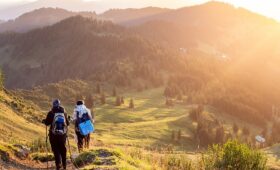Greetings, fellow wanderlusters and Gipfelstürmer (summit conquerors) from Austria! Do the majestic peaks of the Himalayas beckon you, whispering tales of adventure and breathtaking beauty? Look no further than Nepal, the landlocked wonder nestled in the heart of these legendary mountains. But with its distinct seasons impacting trekking conditions, choosing the ideal time for your adventure can feel as challenging as navigating an unmarked trail in the Austrian Alps during winter. Fear not, intrepid Austrians! This comprehensive guide will equip you with the knowledge to choose the best seasons for trekking in Nepal (2025).
Unveiling the Magic of Nepal’s Seasons
Nepal’s diverse climate offers a range of experiences throughout the year. Here’s a closer look at the four distinct seasons and how they impact trekking:
- Spring (March to May):
Spring paints the Nepalese landscape with vibrant colors. Rhododendron forests burst into bloom, creating breathtaking scenery.
Pros: Pleasant temperatures, clear skies, fewer crowds compared to autumn. Cons: Unpredictable weather patterns with occasional rain showers at higher altitudes. Possible lingering snow in some areas requiring extra gear and caution.
- Summer (June to August):
Summer brings the monsoon season, characterized by heavy rainfall and increased humidity.
Pros: Lush green landscapes, vibrant waterfalls, fewer crowds compared to peak seasons. Cons: Treacherous trails due to slippery conditions and potential landslides. Limited visibility due to frequent rain and clouds. Higher risk of altitude sickness due to hot and humid weather.
- Autumn (September to November):
Autumn is often considered the golden season for trekking in Nepal.
Pros: Crystal-clear skies offering stunning mountain views, stable weather patterns with minimal rainfall, comfortable daytime temperatures. Cons: Peak season with higher prices and larger crowds on popular trails. Colder nights at higher altitudes require appropriate gear.
- Winter (December to February):
Winter brings colder temperatures and snowfall, especially at higher altitudes.
Pros: Fewest crowds on popular trails, unique winter landscapes, possibility of experiencing local festivals. Cons: Extremely cold weather conditions requiring specialized gear and experience, many high-altitude passes become inaccessible due to snow, limited daylight hours.
Choosing Your Perfect Season: A Climber’s Guide
The best seasons for trekking depends on your experience level, preferences, and chosen route. Here’s a breakdown to help you decide:
For the Experienced Climber Seeking Optimal Conditions (September-November):
If you’re a seasoned climber seeking stable weather and clear skies for stunning mountain views, autumn (September-November) is your best bet. Comfortable daytime temperatures, minimal rainfall, and clear skies are perfect for long trekking days. However, this is also peak season, so expect larger crowds and potentially higher prices.
For the Adventurer Embracing Lush Landscapes (June-August):
Are you an adventurous trekker who doesn’t mind navigating slightly challenging conditions? The summer monsoon season (June-August) offers a unique experience. Lush green landscapes with cascading waterfalls and vibrant flora paint a different picture of the Himalayas. However, heavy rainfall and potential landslides demand extra caution and the ability to adapt to unpredictable weather.
For the Budget-Conscious Traveler Seeking Fewer Crowds (Spring or Late Autumn):
If managing costs is a priority and you prefer smaller crowds, consider spring (March-May) or late autumn (November). Spring offers pleasant temperatures and beautiful scenery with sporadic rainfall. However, be prepared for potential snow at higher altitudes. Late autumn might offer some post-peak season deals and comfortable trekking conditions but with colder nights at higher elevations.
Additional Considerations for Austrian Trekkers:
- Acclimatization: Regardless of the season, proper acclimatization is crucial for a safe and enjoyable trek. Plan enough time for gradual altitude gain to avoid altitude sickness.
- Gear: Pack appropriate clothing and gear for the chosen season. Even during warmer months, nights at higher altitudes can get cold. Invest in good quality rain gear if trekking during the monsoon.
- Permits and Regulations: Research the necessary permits and regulations for your chosen trek in advance. Austria and Nepal have a close relationship in mountaineering, but specific regulations may apply.
A Final Word: Embrace the Adventure
Nepal, with its diverse landscapes and distinct seasons, offers a trekking experience for every adventurer. Austrian mountain enthusiasts, known for their love of challenge and breathtaking scenery, will undoubtedly find a perfect season and trail to match their ambitions. So, research carefully, choose the season that aligns with your experience and preferences.




